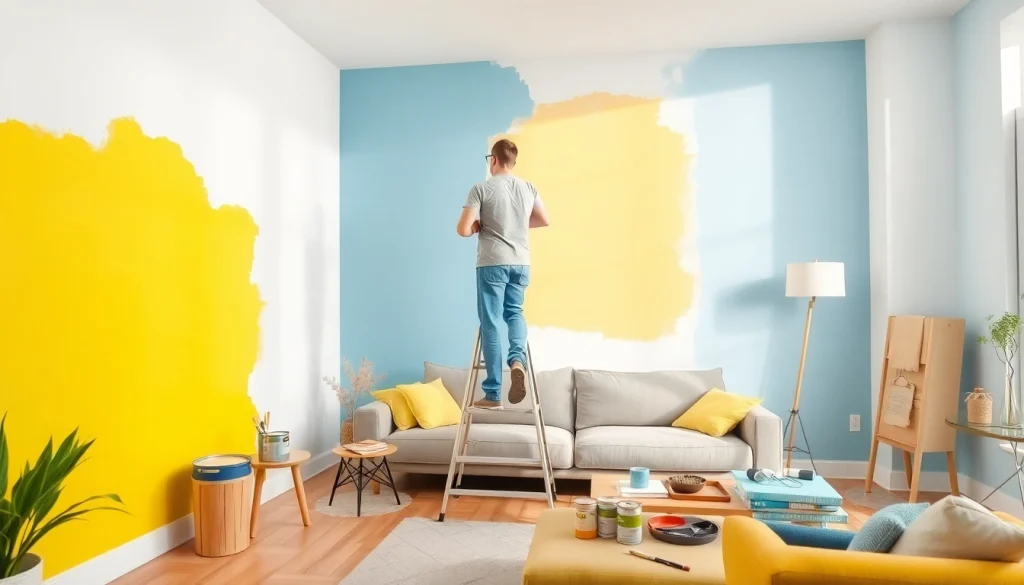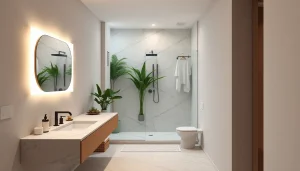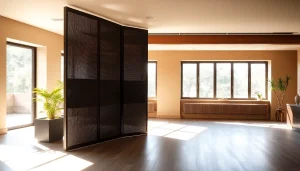Essential Tips and Techniques for Flawless Interior Painting

Understanding the Basics of Interior Painting
What is Interior Painting?
Interior painting involves applying paint to the walls, ceilings, and other surfaces inside your home or office to enhance aesthetics, refresh the environment, and protect building materials. It’s a vital part of home maintenance and improvement that contributes significantly to the overall character of a space. Whether you’re preparing a room for sale or just looking to update your living space, understanding the fundamentals of interior painting can pave the way to achieving aesthetically pleasing results.
Common Types of Interior Paints
When considering interior painting, it’s important to know about the different types of paints available:
- Latex Paint: Water-based and easy to clean up, latex paints are versatile and have low odors. They dry quickly and are ideal for most indoor applications.
- Oil-based Paint: Offering a smooth, durable finish, oil-based paints are often used for trim and moldings. They take longer to dry and require solvents for cleanup.
- Acrylic Paint: Acrylics are similar to latex paints but tend to have better color retention and durability, making them suitable for high-traffic areas.
- Specialty Paints: This category includes options like chalkboard paint, magnetic paint, and low-VOC paints, which are environmentally friendly and emit fewer harmful chemicals.
Preparing Your Space for Painting
Preparation is key to a successful interior painting project. This involves several critical steps:
- Clear the Area: Remove furniture, wall hangings, and other items from the room. If large items can’t be moved, cover them with drop cloths.
- Clean the Surfaces: Dust and clean the walls to ensure proper paint adhesion. Use a mild detergent solution for significant dirt buildup.
- Patch Holes and Cracks: Fill any holes or cracks with spackling paste, then sand the area to create a smooth surface.
- Choose Your Tools: Essential tools may include paintbrushes, rollers, painter’s tape, drop cloths, paint trays, and ladders.
Choosing the Right Colors for Your Interior
Understanding Color Theory
Color theory is the foundation of selecting harmonious color palettes for your interiors. Understanding how colors interact can significantly influence the mood and style of your spaces:
- Complementary Colors: Colors that are opposite each other on the color wheel. They create a high contrast but harmonious look.
- Analogous Colors: Colors next to each other on the color wheel. These combinations are pleasing to the eye and create serene environments.
- Monochromatic Colors: Variations in lightness and saturation of one color. This approach is great for a sophisticated, cohesive look.
How to Pick a Color Scheme
When selecting a color scheme, consider the overall theme of your home, lighting, and the purpose of each room:
- Start with Inspiration: Use magazines, websites, or color palettes to find inspiration. Pinterest and home decor websites are great resources.
- Consider the Room’s Function: A calming color may be ideal for a bedroom, while energizing hues may work well in a home office.
- Match with Existing Elements: Analyze furniture, flooring, and decor before finalizing your colors, ensuring they complement the overall design.
Testing Paint Samples
Before committing to a color, it’s advisable to test paint samples in the space where they will be applied. Here’s how you can effectively test colors:
- Purchase Sample Paints: Buy small amounts of the colors you like.
- Use Paint Swatches: Apply test patches on multiple walls to see how light affects the color throughout the day.
- Observe at Different Times: Check how the paint looks in various lights (natural and artificial).
Best Practices for Interior Painting Projects
Essential Tools and Materials
To achieve a professional-looking finish, having the right tools and materials is essential. Here’s a list of must-haves:
- High-quality paint brushes (angled for trim work and flat for walls)
- Rollers with the right nap for your wall texture
- Drop cloths to protect floors and furniture
- Painter’s tape for clean edges
- Paint trays for rolling
- Ladders or scaffolding for hard-to-reach areas
Step-by-Step Painting Process
Follow this systematic approach to ensure a flawless paint job:
- Prep: Follow the preparation guidelines outlined earlier.
- Start with the Ceiling: Paint the ceiling first, using a roller or brush suitable for the surface.
- Walls: Move on to the walls, using a roller for large areas and a brush for edges and corners.
- Trim and Doors: Finally, paint the baseboards, moldings, and doors to add a completed look.
- Clean Up: Clean brushes and tools; remove painter’s tape while the paint is slightly wet for cleaner lines.
Safety Tips While Painting
Safety should always be a priority during any painting project. Here are some essential safety tips:
- Ensure proper ventilation by opening windows and using fans to circulate air.
- Wear a mask to avoid inhaling paint fumes and dust.
- Use goggles to protect your eyes from splashes.
- Keep ladders stable and follow safe ladder protocol to prevent falls.
Cost Considerations for Interior Painting
Estimating Painting Costs
The cost of interior painting can vary widely based on several factors, including:
- Size of the area being painted
- Quality and type of paint used
- Labor costs if hiring professionals
- Any repairs needed before painting (like patching holes)
Factors Affecting Pricing
While estimating costs, consider the various factors that can influence the final price:
- Geographic Location: Pricing can vary significantly depending on the local market and demand for services.
- Complexity of the Job: Higher complexity, such as detailed trim work or multiple colors, may increase costs.
- Timeframe: Urgent jobs may incur higher labor costs due to the rushed nature of scheduling.
Comparing DIY vs. Professional Services
When deciding between a DIY project and hiring professionals, consider the following:
- DIY: Cost-effective, allows for personal expression, but can be time-consuming and challenging, especially for beginners.
- Professional Services: Offers expertise and efficiency, leading to a quality finish, but comes with higher costs.
Advanced Techniques for Interior Painting
Texturing and Decorative Techniques
If you’re looking to elevate your painting projects, consider incorporating advanced techniques:
- Sponging: A method involving a sponge to create a textured look.
- Strié (Rag Rolling): Rolling a rag over wet paint produces a textured effect.
- Stenciling: Use templates to apply intricate designs and patterns.
Maintaining Your Painted Surfaces
To keep your painted surfaces looking fresh, establish a maintenance routine that includes:
- Regular dusting and cleaning with mild detergents.
- Touch-up painting for small scratches and scuffs.
- Keeping an eye on high moisture areas to prevent mold or peeling.
Common Mistakes to Avoid
Even experienced painters make mistakes. Be aware of the following:
- Skipping the prep work can lead to poor adhesion and finish.
- Choosing a color that seems different in the store compared to how it looks in the room can lead to regret.
- Not using the right tools can result in uneven application and finishing.







